 A new Navigant Research report examines the global market for light electric vehicles (LEVs), providing a detailed analysis of the market opportunities, applications, drivers and challenges, and associated technology trends.
A new Navigant Research report examines the global market for light electric vehicles (LEVs), providing a detailed analysis of the market opportunities, applications, drivers and challenges, and associated technology trends.
Increasing urbanization and a desire to move away from full-sized cars for motorized transportation is setting the stage for a fast-growing LEV market. Globally, LEVs allow for improved personal mobility in terms of affordability and flexibility and help to reduce pollution from the transportation sector. LEV sales are expected to generate $9.3 billion in revenue in 2017 and more than double to a $23.9 billion market by 2026.
“The global LEV market holds significant opportunities for manufacturers and component suppliers, but they are highly varied by geography and technology,” says Ryan Citron, research analyst with Navigant Research. “Low speed EV (LSEV) sales are exploding in China, while the e-scooter industries in Asia Pacific (excluding China) and Europe are poised to expand significantly over the next 10 years as major manufacturers enter new markets and strong regulations on urban transport emissions are implemented.”
A combination of purchase incentives, regulation, and high population densities is currently driving sales of LEVs in Asia Pacific and Europe, which represent the regions with the most opportunity for LEV growth, according to the report. In North America, e-motorcycles are expected to have the largest potential growth due to the region’s huge motorcycle market and a demand for recreational vehicles. However, without competitive products from major manufacturers, consumer awareness is likely to remain low—along with sales. As Li-ion battery costs continue to decrease, Navigant Research expects more e-motorcycle products from major manufacturers to be released into the market.
The report, Light Electric Vehicles, analyzes the global market for LEVs, with a focus on LSEVs, also referred to as neighborhood EVs (NEVs), and e-PTW vehicles such as electric motorcycles (e-motorcycles) and electric scooters (e-scooters). The study provides a detailed analysis of the market opportunities, key market drivers and challenges, and technology trends associated with LEVs. Global market forecasts extend through 2026 and are segmented by technology, region, and three peak motor output categories. The report also provides profiles of key LEV manufacturers and suppliers and analyzes the use of LEVs by private consumers and fleets in mobility, commercial, and recreational applications.